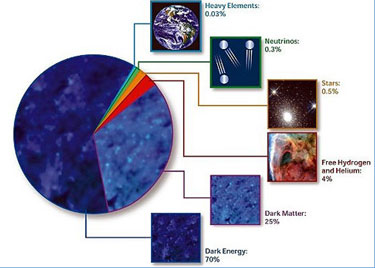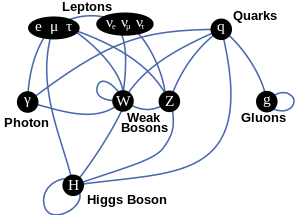The universe is defined as everything that physically exists: the entirety of space and time, all forms of matter, energy and momentum, and the physical laws and constants that govern them. However, the term universe may be used in slightly different contextual senses, denoting such concepts as the cosmos, the world or Nature.
Astronomical observations indicate that the universe is 13.73 ± 0.12 billion years old[1]. Its diameter is at least 93 billion light years, or 880 ×1024 (that is to say, 880 followed by twenty-four zeroes) metres. According to the prevailing scientific theory, the universe has expanded from a gravitational singularity known as the Big Bang, a point in space and time at which all the matter and energy of the observable universe were concentrated. Since the Big Bang, the universe has expanded to its present form, possibly with a "brief period" of cosmic inflation.[2] Several independent experimental measurements support this theoretical expansion and, more generally, the Big Bang theory. Recent observations indicate that this expansion is accelerating, and that most of the matter and energy in the universe is fundamentally different from that observed on Earth and not directly observable (cf. dark matter and dark energy). The imprecision of current observations has hindered predictions of the ultimate fate of the universe.
Experiments suggest that the universe has been governed by the same physical laws and constants throughout its extent and history. The dominant force at cosmological distances is gravity, and general relativity is currently the most accurate theory of gravitation. The remaining three fundamental forces and all the known particles on which they act are described by the Standard Model. The universe has at least three dimensions of space and one of time, although extremely small additional dimensions cannot be ruled out experimentally. Spacetime appears to be smooth and simply connected, and space has very small mean curvature, so that Euclidean geometry is accurate on the average throughout the universe.
The word universe is usually defined as encompassing everything. However, using an alternate definition, some have speculated that this "universe" is one of many disconnected "universes", which are collectively denoted as the multiverse. For example, in bubble universe theory, there are an infinite variety of "universes", each with different physical constants. Similarly, in the many-worlds hypothesis, new "universes" are spawned with every quantum measurement. Since these universes are, by definition, disconnected from our own, these speculations cannot be tested experimentally.
Throughout recorded history, several cosmologies and cosmogonies have been proposed to account for observations of the universe. The earliest quantitative models were developed by the ancient Greeks, who proposed that the universe possesses infinite space and has existed eternally, but contains a single set of concentric spheres of finite size – corresponding to the fixed stars, the Sun and various planets – rotating about a spherical but unmoving Earth. Over the centuries, more precise observations and improved theories of gravity led to Copernicus' heliocentric model and the Newtonian model of the solar system, respectively. Further improvements in astronomy led to the characterization of the Milky Way, and the discovery of other galaxies and the microwave background radiation; careful studies of the distribution of these galaxies and their spectral lines have led to much of modern cosmology.
Definition as connected space-time

- See also: Bubble universe theory and Chaotic inflation
It is possible to conceive of disconnected space-times, each existing but unable to interact with one another. An easily visualized metaphor is a group of separate soap bubbles, in which observers living on one soap bubble cannot interact with those on other soap bubbles, even in principle. According to one common terminology, each "soap bubble" of space-time is denoted as a universe, whereas our particular space-time is denoted as the Universe, just as we call our moon the Moon. The entire collection of these separate space-times is denoted as the multiverse.[12] In principle, the other unconnected universes may have different dimensionalities and topologies of space-time, different forms of matter and energy, and different physical laws and physical constants, although such possibilities are currently speculative.
[edit] Definition as observable reality
- See also: Observable universe and Observational cosmology
According to a still-more-restrictive definition, the universe is everything within our connected space-time that could ever interact with us and vice versa. According to the general theory of relativity, some regions of space may never interact with ours even in the lifetime of the universe, due to the finite speed of light and the expansion of space. For example, radio messages sent from Earth may never reach some regions of space, even if the universe lives forever; space may expand faster than light can traverse it. It is worth emphasizing that those distant regions of space are taken to exist and be part of reality as much as we are; yet we can never interact with them. The spatial region within which we can affect and be affected is denoted as the observable universe. Strictly speaking, the observable universe depends on the location of the observer. By traveling, an observer can come into contact with a greater region of space-time than an observer who remains still, so that the observable universe for the former is larger than for the latter. Nevertheless, even the most rapid traveler may not be able to interact with all of space. Typically, the observable universe is taken to mean the universe observable from our vantage point in the Milky Way galaxy.
[edit] Size, age, contents, structure, and laws
The universe is very large and possibly infinite in volume; the observable matter is spread over a space at least 93 billion light years across.[13] For comparison, the diameter of a typical galaxy is only 30,000 light-years, and the typical distance between two neighboring galaxies is only 3 million light-years.[14] As an example, our Milky Way galaxy is roughly 100,000 light years in diameter,[15] and our nearest sister galaxy, the Andromeda Galaxy, is located roughly 2.5 million light years away.[16]

The observable matter is spread uniformly (homogeneously) throughout the universe, when averaged over distances longer than 300 million light-years.[17] However, on smaller length-scales, matter is observed to form "clumps", i.e., to cluster hierarchically; many atoms are condensed into stars, most stars into galaxies, most galaxies into clusters, superclusters and, finally, the largest-scale structures such as the Great Wall of galaxies. The observable matter of the universe is also spread isotropically, meaning that no direction of observation seems different from any other; each region of the sky has roughly the same content.[18] The universe is also bathed in a highly isotropic microwave radiation that corresponds to a thermal equilibrium blackbody spectrum of roughly 2.725 Kelvin.[19] The hypothesis that the large-scale universe is homogeneous and isotropic is known as the cosmological principle,[20] which is supported by astronomical observations.
The present overall density of the universe is very low, roughly 9.9 × 10−30 grams per cubic centimetre. This mass-energy appears to consist of 73% dark energy, 23% cold dark matter and 4% ordinary matter. Thus the density of atoms is on the order of a single hydrogen atom for every four cubic meters of volume.[21] The properties of dark energy and dark matter are largely unknown. Dark matter gravitates as ordinary matter, and thus works to slow the expansion of the universe; by contrast, dark energy accelerates its expansion.
The universe is old and evolving. The most precise estimate of the universe's age is 13.73±0.12 billion years old, based on observations of the cosmic microwave background radiation.[22] Independent estimates (based on measurements such as radioactive dating) agree, although they are less precise, ranging from 11–20 billion years[23] to 13–15 billion years.[24] The universe has not been the same at all times in its history; for example, the relative populations of quasars and galaxies have changed and space itself appears to have expanded. This expansion accounts for how Earth-bound scientists can observe the light from a galaxy 30 billion light years away, even if that light has traveled for only 13 billion years; the very space between them has expanded. This expansion is consistent with the observation that the light from distant galaxies has been redshifted; the photons emitted have been stretched to longer wavelengths and lower frequency during their journey. The rate of this spatial expansion is accelerating, based on studies of Type Ia supernovae and corroborated by other data.
The relative fractions of different chemical elements — particularly the lightest atoms such as hydrogen, deuterium and helium — seem to be identical throughout the universe and throughout its observable history.[25] The universe seems to have much more matter than antimatter, an asymmetry possibly related to the observations of CP violation.[26] The universe appears to have no net electric charge, and therefore gravity appears to be the dominant interaction on cosmological length scales. The universe appears to have no net momentum and angular momentum. The absence of net charge and momentum would follow from accepted physical laws (Gauss's law and the non-divergence of the stress-energy-momentum pseudotensor, respectively), if the universe were finite.[27]

The universe appears to have a smooth spacetime continuum consisting of three spatial dimensions and one temporal (time) dimension. On the average, space is observed to be very nearly flat (close to zero curvature), meaning that Euclidean geometry is experimentally true with high accuracy throughout most of the universe.[28] Spacetime also appears to have a simply connected topology, at least on the length-scale of the observable universe. However, present observations cannot exclude the possibilities that the universe has more dimensions and that its spacetime may have a multiply connected global topology, in analogy with the cylindrical or toroidal topologies of two-dimensional spaces.[29]
The universe appears to be governed throughout by the same physical laws and physical constants.[30] According to the prevailing Standard Model of physics, all matter is composed of three generations of leptons and quarks, both of which are fermions. These elementary particles interact via at most three fundamental interactions: the electroweak interaction which includes electromagnetism and the weak nuclear force; the strong nuclear force described by quantum chromodynamics; and gravity, which is best described at present by general relativity. The first two interactions can be described by renormalized quantum field theory, and are mediated by gauge bosons that correspond to a particular type of gauge symmetry. A renormalized quantum field theory of general relativity has not yet been achieved, although various forms of string theory seem promising. The theory of special relativity is believed to hold throughout the universe, provided that the spatial and temporal length scales are sufficiently short; otherwise, the more general theory of general relativity must be applied. There is no explanation for the particular values that physical constants appear to have throughout our universe, such as Planck's constant h or the gravitational constant G. Several conservation laws have been identified, such as the conservation of charge, momentum, angular momentum and energy; in many cases, these conservation laws can be related to symmetries or mathematical identities.
[edit] Historical models
- See also: Cosmology and Timeline of cosmology
Many models of the cosmos (cosmologies) and its origin (cosmogonies) have been proposed, based on the then-available data and conceptions of the universe. Historically, cosmologies and cosmogonies were based on narratives of gods acting in various ways. Theories of an impersonal universe governed by physical laws were first proposed by the Greeks and Indians. Over the centuries, improvements in astronomical observations and theories of motion and gravitation led to ever more accurate descriptions of the universe. The modern era of cosmology began with Albert Einstein's 1915 general theory of relativity, which made it possible to quantitatively predict the origin, evolution, and conclusion of the universe as a whole. Most modern, accepted theories of cosmology are based on general relativity and, more specifically, the predicted Big Bang; however, still more careful measurements are required to determine which theory is correct.

Tidak ada komentar:
Posting Komentar